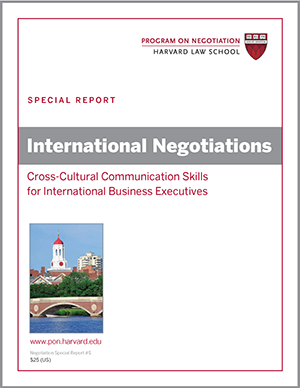
We sometimes require counterparts to meet certain conditions before agreeing to enter into talks. Negotiating conditions to your participation in dealmaking can be a powerful move, but it also carries some risks that need to be carefully considered. And international negotiation brings on more challenges than most.
Let’s look at the international negotiation case study of Microsoft’s decision to purchase Finnish mobile phone company Nokia’s mobile device business for $9.5 billion. The deal, which closed in 2014, quickly proved disastrous: Microsoft wrote off nearly all of the deal’s value and laid off thousands of workers in July 2015. Although there were many reasons the deal was a bad bet for Microsoft, a negotiating condition that Nokia set before agreeing to take part in serious negotiations may have offered one warning sign.
International Negotiation Behind the Microsoft and Nokia Deal: Nokia Builds Its BATNA
Microsoft and Nokia had been partners since 2011, when the Finnish firm began installing Microsoft’s Windows Phone operating system (OS) on its smartphones. But Nokia lagged far behind smartphone competitors in innovation and market share, and the Windows Phone OS, used primarily on Nokia handsets, was failing to meet expectations.
In January 2013, Microsoft CEO Steven Ballmer called Risto Siilasmaa, the chairman of Nokia’s board of directors, to raise the possibility of Microsoft buying divisions of Nokia. Soon after, the two men discussed the idea at a conference in Spain. They agreed inefficiencies existed in their agreement and brainstormed solutions, from minor tweaks to business mergers, reports Ina Fried on the technology news website AllThingsD.com.
Nokia considered letting its deal with Microsoft lapse and trying to revive its handset business by adapting its smartphones to Google’s Android system. By cultivating this strong BATNA, or best alternative to a negotiated agreement, Nokia gained the power to walk away from a subpar offer from Microsoft.
Indeed, after hearing Microsoft’s first formal pitch for an acquisition in New York, Siilasmaa informed Ballmer that they were too far apart on price and other issues, such as which company would own Here, Nokia’s mapping service. Nokia executives believed they needed to hold on to their ability to sell Here to other companies. Meanwhile, Microsoft felt it couldn’t keep pace with competitors without controlling the mapping technology it was using in its phones, tablets, and PCs, and on the web, according to AllThingsD.com. Subsequent meetings between the parties in London and Finland went nowhere.
A Deal Takes Shape
A breakthrough came when Nokia informed Microsoft that it would proceed with formal talks only if Microsoft agreed to abide by certain negotiating conditions, most notably a commitment to set up a financing source for Nokia and the caveat that Here was off the table.
Microsoft agreed. At a meeting in New York, the parties happened upon a solution to the question of who would control the mapping service. Why not share the code, with Nokia retaining intellectual-property rights to Here? Nokia realized it could grant Microsoft a license to access and customize Here’s source code and own any improvements it made. Nokia would retain ownership of Here and the power to license the service to other companies. Ballmer and Siilasmaa shook hands on the outlines of an agreement, which was filled out over the next two months.
The Risks of Setting Negotiating Conditions
A negotiating condition is an “if” statement—such as, “If you agree to take this issue off the table, I’ll negotiate”—that qualifies your entry into a negotiation or acceptance of a deal. Setting negotiating conditions can be a particularly useful tool when it comes to improving the appeal of another party’s onerous request or demand, notes Harvard Business School and Harvard Law School professor Guhan Subramanian
But insisting that the other party agree to certain terms as a precondition to negotiation can be risky. In their 2012 labor dispute, for example, the musicians of the Minnesota Orchestra said for many months that they would negotiate with the orchestra’s management only after a lockout ended. But management was loath to accept this negotiating condition, aware that the players would have little motivation to accept significant salary cuts if they were performing and being paid.
Before stipulating a negotiating condition, remember that your counterpart will weigh the costs and benefits of accepting your negotiating conditions against their alternatives away from the table. If you have a strong BATNA, as Nokia appeared to, then it may make sense to take this risk. But note that even in this case, Microsoft made inroads on the mapping service issue that Nokia had claimed was nonnegotiable. Microsoft may have salvaged the deal by refusing to assume that Nokia’s negotiating conditions were nonnegotiable—a move Microsoft’s leaders likely later came to regret.
Two key lessons on negotiating terms and conditions emerge from these failed negotiation examples. First, you should demand only those conditions that are truly deal breakers for you. Second, try to craft negotiating conditions in ways that provide benefits or concessions to your counterpart. Even when you have the power to get what you want, your efforts to help your counterparts get what they want will pay off in the form of stronger relationships and longer-lasting deals.
Have you had experience negotiating conditions to a deal within an international negotiation? If so, how did the process work out?






There are no more phones with ‘Nokia Lumia’. They are all ‘Microsoft Lumia’. Microsoft completely scraped the company and rebranded the devices. Nokia got a bad future
There has been a completely mixed response to whether the deal was good or was a decision taken in a hurry. Nokia surely can use this incoming cash flow on some great products, but the issue now is that Nokia was recognized by its Mobile Devices and there will be almost zero difference between a new product category (coz no more mobile phones)coming under the NOKIA brand name or a completely new Brand name because they will both have zero popularity in that field.
It would probably be good for Nokia to come up with a new brand name and leave the Nokia legacy behind in its Nokia Research Department and nowhere else. As you could feel, this deal saddens me 🙁
It’s 2015 now buddy and Nokia’s all of microsoft now. You should be a lot sad now 😛